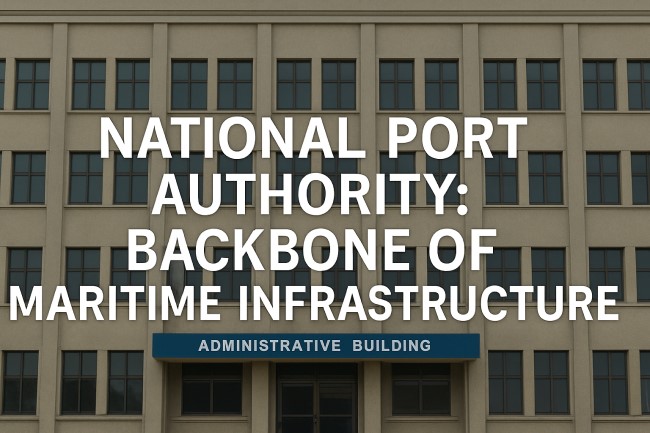National Port Authority: Backbone of Maritime Infrastructure

The National Port Authority is a central government body responsible for managing, developing, and regulating a country’s port systems. Ports are more than just docking points—they are economic lifelines. The efficient functioning of ports has a direct impact on trade, logistics, national revenue, and employment. In this article, we will explore the core functions, structure, global examples, and future prospects of national port authorities.
Understanding the Role of the National Port Authority
What Is the National Port Authority?
The National Port Authority (NPA) is typically a state-owned organization or statutory body tasked with ensuring the safe, sustainable, and economically viable operation of a country’s ports. Whether it operates autonomously or under a Ministry of Transport, its responsibilities are vast and essential.
Key Objectives
-
Develop and maintain port infrastructure
-
Facilitate trade and logistics
-
Enforce maritime laws and safety regulations
-
Promote investment and private sector involvement
-
Coordinate environmental protection measures in maritime zones
Functions of the National Port Authority
1. Port Management and Supervision
The NPA oversees day-to-day port operations. This includes managing berthing schedules, coordinating cargo handling, ensuring efficient turnaround times, and maintaining port facilities such as docks, cranes, and container terminals.
2. Infrastructure Planning and Development
Building modern port infrastructure is a high priority. The authority plans and executes projects related to:
-
Deepening harbors to accommodate large vessels
-
Constructing new terminals and warehouses
-
Upgrading navigation and IT systems
-
Enhancing road and rail links to ports
3. Regulatory Enforcement
The NPA ensures compliance with:
-
International Maritime Organization (IMO) standards
-
Customs and immigration rules
-
Safety and security protocols
-
Environmental laws related to marine pollution
4. Promoting Trade and Economic Growth
Ports serve as gateways to global markets. The NPA works to reduce logistical bottlenecks, lower operational costs, and attract foreign direct investment. In doing so, it helps boost exports, import efficiency, and regional trade.
Organizational Structure of a National Port Authority
Leadership and Governance
A typical NPA is led by a Director-General or Managing Director, supported by department heads for operations, planning, legal affairs, finance, and compliance. The organization often reports to a board or a ministry.
Key Departments
-
Operations Department: Handles all marine and cargo logistics
-
Engineering and Development: Oversees physical infrastructure projects
-
Finance and Administration: Manages budgets, revenue, and internal affairs
-
Legal and Regulatory Affairs: Ensures compliance with national and international laws
-
Environmental and Safety Unit: Monitors pollution control and accident prevention
Real-World Examples of National Port Authorities
Liberia – National Port Authority (NPA)
Liberia’s NPA manages four major ports: Freeport of Monrovia, Buchanan, Greenville, and Harper. It plays a vital role in the country’s timber and mineral exports.
Nigeria – Nigerian Ports Authority
One of Africa’s largest NPAs, it governs key ports including Lagos, Port Harcourt, and Calabar. It has introduced modern reforms to digitize operations and reduce corruption.
Philippines – Philippine Ports Authority
Overseeing more than 100 ports nationwide, the PPA is responsible for port modernization and public-private partnerships. It has successfully enhanced port competitiveness in Southeast Asia.
Challenges Faced by National Port Authorities
1. Aging Infrastructure
Many ports suffer from outdated facilities, shallow drafts, and insufficient cargo-handling equipment, leading to delays and high operational costs.
2. Bureaucracy and Corruption
Red tape and inefficiencies hinder port development and discourage foreign investors. In some countries, port authorities are accused of political interference or mismanagement.
3. Environmental Pressures
With rising sea levels and stricter environmental regulations, NPAs must adopt green practices such as electrified port equipment, waste management systems, and marine conservation efforts.
4. Technological Lag
Digital transformation is crucial. Ports need to implement automated systems for customs clearance, cargo tracking, and real-time communication with shipping lines. Many NPAs are still lagging in this area.
The Future of National Port Authorities
Embracing Smart Port Technology
Future-ready port authorities are integrating Artificial Intelligence (AI), Internet of Things (IoT), and blockchain to increase efficiency, transparency, and predictive planning.
Public-Private Partnerships (PPP)
To overcome funding limitations, NPAs are encouraging private sector participation in infrastructure development, terminal operations, and management of logistics hubs.
Sustainability Goals
Green ports are becoming the new standard. Authorities are investing in alternative fuels, electrified cargo handling, and shore power systems to reduce carbon footprints.
Strategic Importance of Ports in National Development
Economic Engine
Ports contribute significantly to GDP by facilitating exports and imports. They generate employment in sectors like transportation, warehousing, ship repair, and logistics services.
Regional Trade Connectivity
By improving port performance, countries can integrate better into regional trade networks like the African Continental Free Trade Area (AfCFTA) or the ASEAN Economic Community.
Maritime Sovereignty and Security
The port authority works closely with coast guards, customs, and immigration agencies to secure national waters against illegal trade, piracy, and trafficking.
Final Thoughts
The National Port Authority is more than just a government agency—it is a critical pillar of economic infrastructure and national security. As global trade becomes more competitive and environmentally conscious, NPAs must evolve through modernization, transparency, and sustainability.
By managing ports efficiently, enforcing maritime laws, and developing robust infrastructure, these authorities support not only the movement of goods but also the movement of economies.



